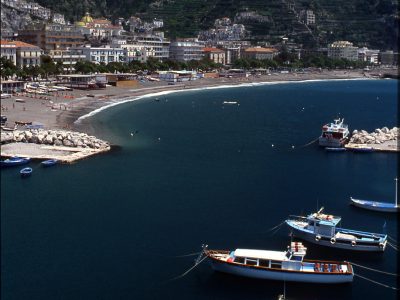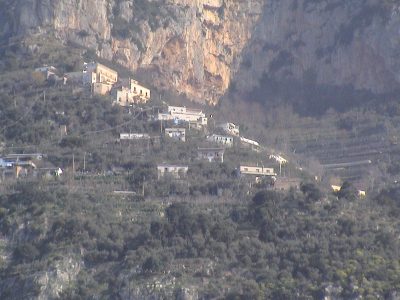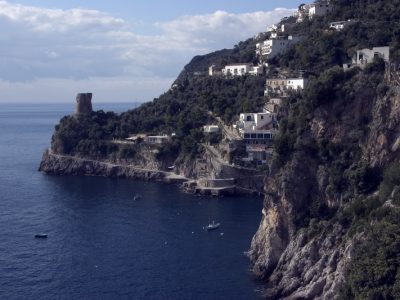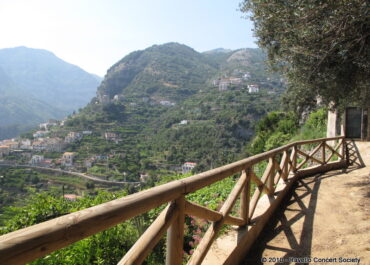Emerged Nature

In each season, Amalfi Coast, offers a particular sight linked to nature. Departing from spring flowering of lemon trees or of first vine leaves, to deep green of wood and to sparkling blue of sea summer, to warm autumn colours with chestnut woods full of fruits ready to fall down in the grass when the first rainstorm comes, to white winter sea waves or to the enchanting sleepy mountains and hills during winter time: each season has its colour but it is always enchanting and it is able to fascinate also the most inattentive traveler.
To complete this offer there are some oasis with high naturalistic values: Ferriere valley between Scala and Amalfi with a reserve where Woodwardia radicans grows, Vallone Porto of Positano, where nature has been influenced by the high humidity level, maquis of Capodorso in Maiori, the mix of nature and architecture at Furore fjord, the view on the whole coast from Dei path.

Amalfi
Amalfi offers the opportunity with its several hamlets, linked to the urban centre, to live not only sea but also the part connected to greenery components of Costiera Amalfitana. In the northern part, which is also reachable through stairs that in the first part cross the urban centre, it is possible to visit Ferriere Valley, which encloses architectonic witnesses of the first examples of paper and iron industrial production and greenery heritage representing an exclusive example in the coast. In fact, in the highest part of the valley - which represents the natural reserve where the fern woodwardia radicans grows - it is possible to enter attended or it is possible to walk along Chiarito river in a greenery that appears inverse compared to altimetric belts: beech and live oach woods in the valley bottom whereas maquis when you go to high altitude.

Atrani
Atrani arises in the valley bottom created by Dragone river that coming down from mountains which surround Scala, eroded this deep fracture between Aureo Mountain, so called because of the golden colouration produced by sun light on calcareous stone, and Civita Mountain, which overlooks it in the eastern part. Exactly on these mountain walls and especially on the one of Aureo Mountain there are numerous phenomenon of carsism which originate grottos more or less deep of which the major one, called Masaniello grotto, encloses a lot of labored stone elements formed by very hard water. It is easy to visit because it is not very deep and it represents a nice mix of nature and history since inside it is possible to see traces of human attending.

Cetara
Cetara rises in the valley excavated by Cetus torrent and it is characterized by all elements of the typical landscape of Costiera Amalfitana. In fact there is sea with fish world, the mountain with a vegetation mixed between wood and maquis, and in the middle as surrounding of the living area, there are terraced gardens that in some points reach the sea. In these gardens lemons and grapevines are mixed with vegetable garden but all these elements are necessary to define the green background of the village; this green is only interrupted by white houses and grey stones used to build dry-stone walls.

Conca dei Marini
Conca dei Marini, situated in the middle of the whole coast, delimitated in the north by Agerola mountains and in the south from the sea it offers a natural sight linked to agriculture, with terraced gardens dedicated to vineyards and to spontaneous vegetation which represents the shift from maquis to wood. Till the beginning of the last century, natural environment of Conca was characterized by numerous “scioscellati”, gardens with carob trees. The tradition of this cultivation deepens its roots in numerous uses that it was possible to do with this product, ranging from rosary beads, to food for pack animals to alcohol which could be distilled by its fruits. Furthermore, in great poverty periods carobs became the cake on feast occasions, in fact it was considered “chocolate of poor people”. In its territory there is also a naturalistic evidence very famous at national and international level: Smeraldo Grotto. This cavity, discovered in 1932, has become an attraction for tourists for green sea reflections that there are inside it and which are produced by sun light which filters through a small submerged siphon.

Furore
Furore offers to the visitor the opportunity to move freely from a characteristic nature of the hill area, that seems nearly mountain nature, to the one typical of the coast. Among terraced gardens cultivated with vineyards, from which it is possible to produce grapes, then changed into DOC wines, and typical vegetal gardens where it is possible to see mixed cultivation of vineyards and of local vegetables, you have the opportunity to descend towards the fjord through some steps. This deep inlet, where there is the meeting between nature and man action, allows to appreciate the complexity of Costiera Amalfitana: among sea waves that also reach the woods which arrive as far as the beach, fishermen houses, were built. During fishing season fishermen did not return to the village but remained down in the fjord.

Maiori
Maiori offers to the visitor the opportunity to combine sea and mountain. The beach, one of the longest and widest of Costiera, with its sand and not very big rocks, allows anyone to be able to enjoy a wonderful sea above all in May, June and September. At the back of the built-up area, instead, in west a pinewood and in east terraced-gardens introduce to the other natural component of Maiori. Walking through terraced-gardens, thanks to ancient stairs, it is possible to leave the village to climb to Falerzio Mountain, where after passing maquis, chestnut- and live oak woods, you reach Madonna dell’Avvocata hermitage, from where it is possible to enjoy one of the most beautiful landscapes on the whole Costiera, being able to see, during days with fine weather, also Capri isle.

Minori
Minori offers to the visitor to combine sea to hill. The small beach, in fact, allows to enjoy the sea above all during the months before the out-and-out summer season, while nice walks in the valley situated in the northern area of the built up area lead the less careless voyager in a world that you hardly would aspect to find looking the coast. Typical woods of Costiera Amalfitana are near interweaved to terraced garden with lemon trees (Minori has always been the principal trade centre for fruits), and between roaring canals which bring water to gardens or the strongest roar of Reghinna torrent it is possible to arrive to S. Nicola, where at the shade of a monastery, not lived anymore, it is possible to admire a nice landscape which sweeps from Ravello as far as Maiori.

Positano
Positano is known in the world above all for its fame of tourism centre linked to the sea, but if you visit deeply the territory you can make interesting discoveries. In the upper part of the village there is the street which brings to two places, at hill level, Montepertuso and Nocelle, which have all characteristics of places at high sea level: terraced gardens of lemon and grape gardens with farmhouses, woods, chestnut woods and above all paths. Just in Nocelle and Montepertuso, in fact, the final part of the famous “Dei path” arrives; it is so called for the breathtaking beauty of landscapes which sweep from Sele plain, near Paestum, as far as Capri isle. Along the path it is possible to meet typical plants of these altitudes, departing from wood in the initial part of the route as far as maquis in the intermediate and final area, as well as religious architecture witnesses. In the lower part of Positano, instead, on the one side Mulini valley collects next to proto-industrial witnesses, naturalistic and fauna evidences typical of a humid environment, on the other side in “Vallone Porto” it is possible to visit one of the few naturalistic oasis where the high gradient of humidity and favourable wind drafts reproduce a small tropical forest with numerous plant species among which orchids and ferns or to meet amphibious normally only present at tropical latitudes.

Praiano
Praiano, even though it is a centre of costal strip, it has an area upstream the built up area which has all characteristics of hill centres with wide terraced areas but a lot of maquis too. In fact, the territory of this area of the coast has an index of terraced area lower than the eastern area since the economy of these places was more linked to fishing and then springs are less present and spread. The upper area of the municipality is crossed by Dei path with its breathtaking landscapes and vegetation which departs from woods in the initial part of the route to arrive to maquis, with arbutus and blueberries, whose fruits, especially in autumn, cheer up excursionists. Just along the path it is also possible to see one of the most beautiful monastery, the one of S. Maria del Castro.

Ravello
Ravello offers to the more careful visitor and to the one who does not stop to visit only the most important and known monuments, the opportunity of interesting walks along the paths which link the centre with the opposite Scala or that go towards the highest mountains, walking through the ancient road links. Walking through these paths it is possible to pass from terraced gardens with vineyards as far as chestnut woods and high altitude woods, meeting examples of hawks which nest along rock faces. If instead of going up you descend towards the sea, it is possible to cross, walking through ancient steps, rich lemon gardens whose concentration is maximum in some points.

S. Egidio del Monte Albino
S. Egidio del Monte Albino shows a typical vegetation of a centre situated at the bottom of a mountain with at the back a mountain which nearly reaches 900 metres on sea level. Chestnut woods are mixed with live-oak woods and with little spaces with terraced gardens in the lower part of the mountain. Numerous paths well signed allow to come into contact with this nature that in autumn offers wood products, from chestnuts to mushrooms, to the visitor. Along the streets of the village instead gardens, not terraced anymore but near always a ripa, allow cultivation of citrus trees and particularly of oranges, whose fruits, after being cropped up, are preserved for a long time in grottos or in “revote” (deposits) which there are in the same gardens.

Scala
Scala offers to the visitor the possibility to come in contact with a nature which sweeps form hill to high mountain. Crossing big chestnut woods you reach, in fact, mountains higher than 1000 metres and that, in addition to offering enchanting views on the whole coast, preserve an unspoiled nature made of fruit timber trees and an underwood rich of essences that still today are picked up for liqueurs and for local gastronomy (oregano, juniper berries, wild rose berries, etc.) Instead walking towards Ferriere valley you enter into a completely different environment: humidity and microclimate allow the growth of a particular fern that normally roots at tropical latitudes, the woodwardia radicans, protected in a natural reserve, whose visit is highly recommended.

Tramonti
A high mountain nature welcomes the visitor who goes to Tramonti. Crossing woods you meet very interesting naturalistic elements: chestnut woods which are cultivated not only for fruits but also for wooden poles and once for baskets and cradles for children, places rich of stones with vegetation elements typical of high altitudes and paths that once constituted the Alta Via of Lattari Mountains. In the lower area, the one near human settlements, it is possible to see cultivated areas not terraced one but at abrupt, that is with a major inclination compared to classic terraced gardens and near always without stone walls (this happens because of the clay nature of land). In these places grape is cultivated and it is transformed in DOC wine.

Vietri sul Mare
Vietri sul Mare nature offers to the visitor the opportunity to sweep from sea (the beach is one of the longest of Costiera Amalfitana) to hills with terraced gardens. Bosco Croce oasis draws up the visitor to an uncontaminated nature among lemon gardens but also holm oaks, brooms and the most used essences of local cooking (thyme, rosemary, bay and oregano).

Corbara
Corbara expands itself at Chiunzi mountainside in the northern side of Lattari Mountains at the borders of the plain delimitated by the volcanic complex of Somma - Vesuvio Mountain and by the sea. In this area the vegetation feels this position therefore there is, above all in the upper area of the village, a strong presence of woods where between century chestnut trees and trees for wood there are terraced gardens less spread than those of the coast and dedicated to vineyard cultivation and to a typical cherry tomato, called “corbarino”, which has a small and at the same time lengthened shape and for the whole winter period it is preserved at bunch in cellars and in kitchens of houses of this area.

